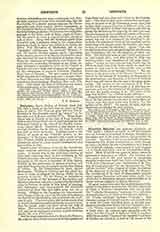

Dionysius Exiguus, the surname EXIGUUS, or “The Little”, adopted probably in self-depreciation and not because he was small of stature, flourished in the earlier part of the sixth century, dying before the year 544. According to his friend and fellow-student, Cassiodorus (De divinis Lectionibus, c. xxiii), though by birth a Scythian, he was in character a true Roman and thorough Catholic, most learned in both tongues—i.e. Greek and Latin—and an accomplished Scripturist. Much of his life was spent in Rome, where he governed a monastery as abbot. His industry was very great and he did good service in translating standard works from Greek into Latin, principally the “Life of St. Pachomius”, the “Instruction of St. Proclus of Constantinople” for the Armenians, the “De opificio hominis” of St. Gregory of Nyssa, the history of the discovery of the head of St. John the Baptist. The translation of St. Cyril of Alexandria‘s synodal letter against Nestorius, and some other works long attributed to Dionysius; are now acknowledged to be earlier and are assigned to Marius Mercator.
Of great importance were the contributions of Dionysius to the science of canon law, the first beginnings of which in Western Christendom were due to him. His “Collectio Dionysiana” embraces (I) a collection of synodal decrees, of which he has left two editions: (a) “Codex canonum Ecclesiae Universae”. This contains canons of Oriental synods and councils only in Greek and Latin, including those of the four ecumenical councils from Nicaea (325) to Chalcedon (451). (b) “Codex canonum ecclesiasticarum”. This is in Latin only; its contents agree generally with the other, but the Council of Ephesus (431) is omitted, while the so-called “Canons of the Apostles” and those of Sardica are included, as well as 138 canons of the African Council of Carthage (419).
(c) Of another bilingual version of Greek canons, undertaken at the instance of Pope Hormisdas, only the preface has been preserved. (2) A collection of papal Constitutions ‘Collectio decretorum Pontificum Romanorum) from Siricius to Anastasius II (384-498).
In chronology Dionysius has left his mark conspicuously, for it was he who introduced the use of the Christian Era (see General Chronology) according to which dates are reckoned from the Incarnation, which he assigned to March 25, in the year 754 from the foundation of Rome (A. U. C.). By this method of computation he intended to supersede the “Era of Diocletion” previously employed, being unwilling, as he tells us, that the name of an impious persecutor should be thus kept in memory. The Era of the Incarnation, often called the Dionysian Era, was soon much used in Italy and, to some extent, a little later in Spain; during the eighth and ninth centuries it was adopted in England. Charlemagne is said to have been the first Christian ruler to employ it officially. It was not until the tenth century that it was employed in the papal chancery (Lersch, Chronologie, Freiburg, 1899, p. 233). Dionysius also gave attention to the calculation of Easter, which so greatly occupied the early Church. To this end he advocated the adoption of the Alexandrian Cycle of nineteen years, extending that of St. Cyril for a period of ninety-five years in advance. It was in this work that he adopted the Era of the Incarnation.
JOHN GERARD

